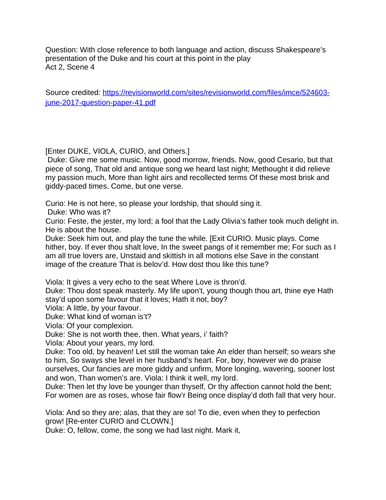

Contextual Understanding: Brief background information on the Duke (Orsino) and the setting of the court in Illyria. Exploring the societal norms, hierarchy, and dynamics of the court during Shakespeare’s time, highlighting their influence on characters’ actions and language.
Character Analysis: Detailed analysis of Duke Orsino’s language and actions at the specific point in the play being referenced. Delving into his speeches, soliloquies, and interactions with other characters to uncover his temperament, desires, and attitudes toward love, authority, and self-perception.
Language Analysis: Examination of Orsino’s use of poetic language, metaphors, and imagery when expressing his love for Olivia. Analyzing how his language reflects his romantic idealism and fluctuating emotions.
Action and Behavior: Evaluation of Orsino’s actions and behaviors within the court, particularly in relation to his pursuit of Olivia. Exploring how his actions reveal aspects of his character and his approach to courtship.
Comparative Analysis: Drawing comparisons between Orsino’s behavior and that of other characters within the court, such as Olivia or Malvolio, to highlight contrasts in their approaches to love, power, or social status.
A sample answer might delve into Orsino’s character, his language, and actions in Act 1, Scene 1, where he expresses his deep infatuation for Olivia. Here’s a brief excerpt of how such an analysis could begin:
“In Act 1, Scene 1 of ‘Twelfth Night,’ Shakespeare intricately portrays Duke Orsino within the confines of his court, unveiling a complex persona marked by romantic fervor and a distinctive approach to love. Orsino’s language, drenched in poeticism and metaphorical imagery, offers a glimpse into his emotional disposition and his perception of courtly love. His opening lines, ‘If music be the food of love, play on,’ serve as a poetic declaration encapsulating his insatiable desire for romantic fulfillment.”
The sample answer would proceed to dissect Orsino’s language, referencing specific lines and analyzing their metaphorical implications and emotional resonance. It would then segue into his actions and interactions within the court, illustrating how these actions align or diverge from his professed sentiments.
The analysis would ultimately provide a nuanced understanding of Orsino’s character and his court, drawing connections between his language, actions, and the broader themes of love, desire, and authority in the play.
Something went wrong, please try again later.
This resource hasn't been reviewed yet
To ensure quality for our reviews, only customers who have purchased this resource can review it
Report this resourceto let us know if it violates our terms and conditions.
Our customer service team will review your report and will be in touch.